|
|
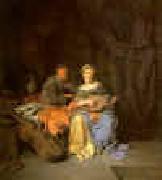 |
Cornelis Bega
|
|
1632-1664
Dutch
Cornelis Bega Galleries
Dutch painter, draughtsman and etcher. He was born into prosperous circumstances; his mother, Maria Cornelis, inherited half the estate (gold, silver, paintings, drawings and prints) and all of the red chalk drawings of her father, Cornelis Cornelisz. van Haarlem, a renowned Mannerist artist. Begas father was Pieter Jansz. Begijn (d 1648), a gold- and silversmith. Like other family members, Bega was probably Catholic. Houbrakens claim that Bega studied with Adriaen van Ostade is likely to be correct; this was probably before 24 April 1653, when Bega joined Vincent Laurentsz. van der Vinne in Frankfurt for a journey through Germany, Switzerland and France. Bega had returned to Haarlem by 1 September 1654, at which time he joined the Guild of St Luke; he was already a competent draughtsman, as indicated by his first extant dated work, Interior with a Nursing Mother (1652; Frankfurt am Main, Stedel. Kstinst.), and by a remarkable double portrait (Amsterdam, Rijksmus.) drawn by him and Leendert van der Cooghen in 1654.
|
|
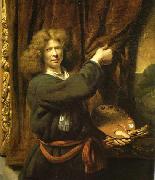 |
Cornelis Bisschop
|
|
In ca. 1650 he was a student of Ferdinand Bol in Amsterdam. In 1653 he was back in Dordrecht, where he got married. According to Houbraken he was the first to paint carved trompe l'oeil wooden panels in such an ingenious way that they became quite popular. He painted historical allegories, portraits, still lifes, and genre-works. He was asked to paint for the Danish court, but he died unexpectedly, leaving his wife and eleven children. Of these children, two sons (Abraham (1660-1700) & Jacobus Bisschop (1658-1698)) and three daughters became painters. These had been his students when he died, and Margaretha van Godewijk studied with his daughters. She wrote an emblem about his self-portrait with a curtain, which illustrates the legend of Zeuxis.
His son Jacobus later became a student of Augustinus Terwesten in the Confrerie Pictura
|
|
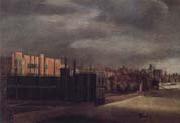 |
Cornelis Bol
|
|
Dutch, born circa 1589-1666,Painter, etcher and draughtsman, active in London. He was probably from a family of painters originating in Mechelen who later settled in Antwerp. Bol and his wife were members of the Dutch Church in London in 1636. An etching of an Action between the Dutch and Spanish Fleets (Oxford, Bodleian Lib.) is signed and dated 1639, and a set of etchings by him after Abraham Casembrot ( fl c. 1650-75) includes a view of Lambeth Palace as well as four imaginary Mediterranean seaports. A signed drawing of the Blockhouse at Gravesend is in the British Museum, London. George Vertue saw at Wotton House, Bucks, 'three views of London from the River side Arundel House Somersett house Tower Lond. painted before the fire of London by Cornelius Boll: a good free taste'. They were probably commissioned by John Evelyn, the diarist, around 1660 and descended in the Evelyn family. Their attribution to Bol is confirmed by a signed version of Somerset House (London, Dulwich Pict. Gal.). Although Bol was only moderately accomplished, he was able to reproduce the distinctive light and character of the River Thames and to render the riverside and its landmarks with much topographical detail; his pictures make pleasing visual documents. The handling of the naval craft is identical in a small signed oil panel of an Action between Dutch and Spanish Ships (Amsterdam, Rijksmus.) and in other marine subjects that have appeared in London salerooms. According to Immerzeel, Bol was still working in London at the time of the Great Fire in 1666. |
|
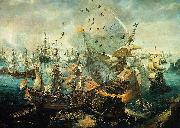 |
Cornelis Claesz. van Wieringen
|
|
He was the son of a Haarlem captain, and drew, painted and etched with his friends Hendrick Goltzius and Cornelis van Haarlem. He also held important positions in the Haarlem Guild of St. Luke, the painters guild, where he became a member in 1597.
He specialized in paintings depicting ships and sea battles, and received orders from the municipal councils of Haarlem and Amsterdam. He painted the most popular picture of the Damiate legend of Haarlem, showing how a Haarlem ship broke the protective chain at Damietta during the Fifth Crusade, resulting in an important victory over Islam. This painting was such a success that it was reordered in tapestry form, and both pieces are in the collection of the Frans Hals Museum.
The city of Haarlem archives still hold the original records of the 1629 order to Van Wieringen to make the tapestry, the largest made in the 17th century (10.75 meters long and 2.40 meters high). This tapestry still hangs on the wall of the Haarlem City Hall council meeting room known as the vroedschapskamer, where it was installed. It is on public display once a year on Monument Day.
|
|
|
|
|
|
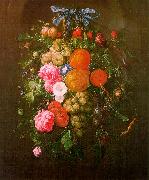 |
Cornelis de Heem
|
|
Dutch Baroque Era Painter, 1631-1695
Son of Jan Davidsz. de Heem. He spent a great deal of his life in Antwerp, where he was taught by his father. Cornelis also worked in Utrecht in 1667, in nearby IJsselstein in 1676 and in The Hague from 1676 for more than ten years. His best works approach the quality of his father, particularly in works executed during the decade starting in 1655. Cornelis still-lifes can be distinguished by daring colour harmonies, sometimes with a strong blue. His compositions are often simpler: fruit-pieces, floral bouquets, festoons and garlands and sumptuous still-lifes, only occasionally in large formats. His technique changed from a more painterly to a more graphic style. |
|
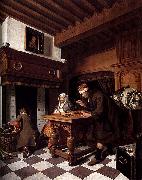 |
Cornelis de Man
|
|
(Delft, 1 July 1621 - Delft, 1 September 1706) was a Dutch Golden Age painter.
Kornelis was not satisfied with life in Delft. He wanted to travel beyond the port of Dordrecht and that is what he did, spending a year in Paris as soon as he came of age and had enough talent to pay his way with his painting skills. He was well-received, but set off in the Spring for Lyon in order to cross Lombardia and the mountains before another winter set in. He settled for two years in Florence, where he had a rich patron, but stayed the longest in Rome. On the way back home he stopped in Venice, and in the end was gone for a total of nine years |
|
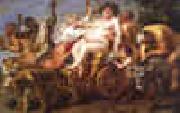 |
Cornelis de Vos
|
|
1585-1651
Flemish
Cornelis de Vos Gallery
Flemish portrait and figure painter. He was a contemporary of Rubens, who sent many sitters to him. Although of the school of Rubens, Vos developed an individual style of portraiture in which cool grays predominate. His representations of children were particularly successful. An example of his many portraits is that of Abraham Grapheus (Antwerp). His brother, Paulus de Vos, c.1596?C1678, was an excellent painter of animals and hunting scenes. His paintings show the influence of his brother-in-law, Frans Snyders. His work is best seen in the museums of Madrid and St. Petersburg. |
|
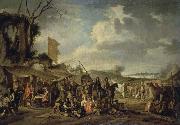 |
Cornelis de Wael
|
|
Cornelis de Wael (1592-1667) was a Flemish painter of the Baroque period, active mainly in Italy, specifically Genoa. He was born in Antwerp, the son of a painter, and died in Rome.
|
|
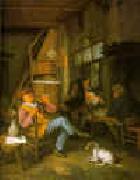 |
Cornelis Dusart
|
|
1660-1704 Dutch
Dutch painter, draughtsman and printmaker. He was the son of the organist at St Bavo in Haarlem and one of the last pupils of Adriaen van Ostade. He became a member of the Haarlem Guild of St Luke on 10 January 1679 and served as its dean in 1692. Dated pictures by Dusart have survived from almost every year between 1679 and 1702. Two of his earliest pictures of peasants relied heavily on compositions by van Ostade: Mother and Child (1679; Dresden, Gemeldegal. Alte Meister) and Woman Selling Milk (1679; sold Amsterdam, Muller, 16 Oct 1928, lot 9; the original drawing by van Ostade is in Paris, Fond. Custodia, Inst. Neer., see Schnackenburg, 1981, no. 132). |
|
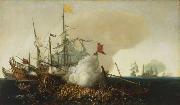 |
Cornelis Hendriksz Vroom
|
|
(1591, Haarlem - buried September 16, 1661, Haarlem) was a Dutch Golden Age landscape painter.
According to the RKD he was the son of the painter Hendrick Cornelisz Vroom, the older brother of Frederick and Jacob, and the father of the painter Jacob Cornelisz Vroom.[1] He became a member of the Haarlem Guild of St. Luke in 1634.
According to Houbraken in 1718, who repeated a list of names from Theodorus Schrevelius's 1648 book on Haarlem called Harlemias, he was the son of Hendrick Cornelisz Vroom and a good landscape painter of Haarlem along with "Joh. Jakobsz.", who was in Italy for many years, "Nicol. Zuyker", Gerrit Claesz Bleker, Salomon van Ruysdael, and Reyer van Blommendael. |
|
 |
Cornelis Holsteyn
|
|
(1618 - 2 December 1658) was a Dutch Golden Age painter from Haarlem.
According to the RKD he was a painter of historical allegories, portraits, and interior decorations, trained by his father Pieter Holsteyn I. According to Houbraken, his father was a glass painter, and thus was trained for glass painting, but the market in glass painting not being what it was, he turned his hand to painting canvas. Houbraken felt he received less for a painting than he deserved, because his work was of a very high quality. He describes a Triumph of Bacchus, and a Lycurgus, which was painted for the Amsterdam Orphanage.
According to the RKD, he moved to Amsterdam with his brother Pieter Holsteyn II in 1647, became poorter there in 1652, and was betrothed there on Christmas eve, 1654. He was buried in the Nieuwe Kerk on December 2, 1658 from his home on the Rozengracht. Houbraken claimed he had been fit until his sudden death by Hartvang, or heart-attack.
|
|
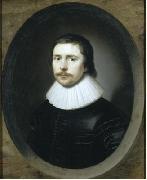 |
Cornelis Janssens van Ceulen
|
|
(also Cornelius Jonson van Ceulen, Cornelius Johnson, Cornelis Jansz. van Ceulen and many other variants)(bapt. October 14, 1593, London - bur. August 5, 1661, Utrecht) was an English painter of portraits of Dutch or Flemish parentage. He has been described as "one of the most gifted and prolific portrait painters practising in England during the 1620s and 1630s".
Janssens van Ceulen was born to Dutch or Flemish parents in London - his father had been a refugee from Antwerp, and the family had originated in Cologne. He was baptised at the Dutch church at Austin Friars, the son of Johanna le Grand and Cornelius Johnson. He may have been trained in the Netherlands, and was certainly influenced by other artists from the Netherlands, but he was active in England, at least from 1618 to 1643. In the 1620s, he lived and had his studio in Blackfriars, London, as did Anthony van Dyck; it was just outside the boundaries of the City of London, and so avoided the monopoly in the City of members of the London painters' Guild. He married Elizabeth Beke of Colchester in 1622. Janssens' son (Cornelius Janssens, junior) was born in 1634. He was also a painter. Janssens' daughter was married to Nicholas Russell of Bruges. Janssens moved to Canterbury in the mid 1630s, living with Sir Arnold Braems, a Flemish merchant. Janssens continued to live in England until after the outbreak of the English Civil War, but in October 1643, apparently at the insistence of his wife, he moved to Middelburg, and between 1646 and 1652 he lived in Amsterdam, before settling in Utrecht, where he was buried. |
|
|
|
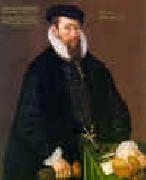 |
Cornelis Ketel
|
|
Flemish (Resident in UK)
1548-1616 Cornelis or Cornelius Ketel (Gouda, 18 March 1548 ?C Amsterdam, 8 August 1616) was a Dutch Mannerist painter, active in Elizabethan London from 1573 to 1581, and in Amsterdam from 1581 to the early 1600s, now known essentially as a portrait-painter, though he was also a poet and orator, and from 1595 began to sculpt as well.
According to Ketel's biography, written by his contemporary Karel van Mander, he seems to have wanted to concentrate on the most prestigious of the hierarchy of genres, history painting, which included mythological subjects, but after he left France he is known almost entirely as a portrait-painter. Neither England nor Holland had much demand for large history paintings during his lifetime, and none of Ketel's histories or allegorical paintings are known to have survived intact, although drawings and prints survive. He did however significantly influence the development of the largest type of painting commonly produced in the United Provinces at this period, the civic group portrait
|
|
|
|
|
|
 |
Cornelis Norbertus Gysbrechts
|
|
(ca 1630 - after 1683) was a Flemish painter of still life and trompe-l'œil active in the second half of the seventeenth century.
Gysbrechts was born in Antwerp, where, according to the RKD, he became a member of the Guild of St. Luke in 1660. He signed his name with "CND". His first known paintings date from 1659 in Antwerp. He painted in 1664 in Regensburg, from 1665-1668 in Hamburg and from 1668 to 1672 at the court in Copenhagen. |
|
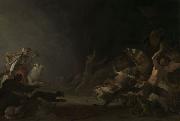 |
Cornelis Saftleven
|
|
(c. 1607, Gorinchem - 1 June 1681, Rotterdam) was a Dutch Golden Age painter
He was born into a family of artists, and learned to paint from his father Herman, along with his brothers Abraham and Herman Saftleven the Younger. He lived for a time in Utrecht with his brother.
Saftleven's subject matter covered various subjects, including genre works, portraits, beach scenes, and biblical and mythological themes. Some consider his images of Hell to be his most individual contribution to Dutch painting
|
|
|
|
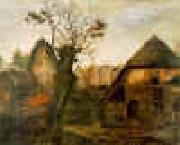 |
Cornelis van Dalem
|
|
1535-1576
Dutch
Cornelis van Dalem Location
Flemish painter. He was the son of a well-to-do cloth merchant living in Antwerp, but of Dutch origin. Cornelis received a humanistic education. His father, who owned land in Tholen, as a vassal to the Counts of Holland and Zeeland, was dean of the chamber of rhetorics De Olijftak (The Olive Branch) in Antwerp in 1552-3. According to van Mander, Cornelis was himself learned in poetry and history and only painted as an amateur, not for a living. Documents in the Antwerp archives invariably refer to him as a merchant, never as a painter, which no doubt accounts for the small number of known paintings by him. He learnt to paint with an otherwise unknown artist, Jan Adriaensens, who had also taught his older brother Lodewijk van Dalem ( fl 1544-85). The latter was inscribed as a pupil in 1544-5 and became a master in the guild in 1553-4. Cornelis was himself inscribed a year after his brother, and he became a master in 1556, the same year he married Beatrix van Liedekercke, a member of an Antwerp patrician family. They lived in Antwerp until late 1565, when, apparently for religious reasons, they left for Breda, together with the artist mother, who had become a widow in 1561. In 1571 several local witnesses testified that van Dalem, who was then living in a small castle, De Ypelaar, in Bavel, near Breda, was strongly suspected of being a heretic. He was never seen in church and was said, on the contrary, to have often attended Protestant services and to have publicly expressed contempt for Papists. |
|
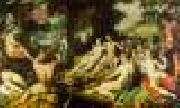 |
CORNELIS VAN HAARLEM
|
|
Dutch painter (b. 1562, Haarlem, d. 1638,
Dutch painter and draughtsman, was one of the leading Northern Mannerist artists in The Netherlands, and an important forerunner of Frans Hals as a portraitist. Cornelis Corneliszoon was a member of the Mannerist school of Haarlem, which was highly influenced by the work of Bartholomeus Spranger, whose drawings were brought to Haarlem by Carel van Mander in 1585, and had a strong immediate effect.[1] He painted mainly portraits as well as mythological and Biblical subjects. Initially Corneliszoon painted large-size, highly stylized works with Italianate nudes in twisted poses with a grotesque, unnatural anatomy. Later, his style changed to one based on the Netherlandish realist tradition. When his parents fled Haarlem in 1572, as the Spanish army laid siege to the city during the Eighty Years' War, Corneliszoon remained behind and was raised by the painter Pieter Pietersz., his first teacher. Later, Corneliszoon studied in Rouen, France and Antwerp, Belgium. Corneliszoon in 1583 received his first official commission from the city of Haarlem, a militia company portrait, the Banquet of the Haarlem Civic Guard. He later became city painter of Haarlem and received numerous official commissions. As a portrait painter, both of groups and individuals, he was an important influence on Frans Hals. Together with Carel van Mander, Hendrick Goltzius and other artists, Corneliszoon formed the Haarlem Academy or "Haarlem Mannerists". Probably this was a very informal grouping, perhaps meeting to draw nude models, and certainly to exchange artistic views.[2] Corneliszoon also played a role in reorganizing the Haarlem artists' and artisans' Guild of St. Luke, eliminating its medieval organization and raising the status of the artists. Corneliszoon married Maritgen Arentsdr Deyman, the daughter of a mayor of Haarlem, sometime before 1603. |
|
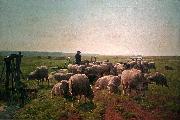 |
Cornelis Van Leemputten
|
|
(1841-1902) was a Belgian painter.
Born in Werchter, Cornelius van Leemputten is predominantly known for his landscapes with sheep, similar to the style of Charles Jacque. He began his painting career without formal training. He was well-known for his barnyard subjects. Leemputten eventually became a pupil of the Academy of Antwerp, though his style remained primarily self-taught.
Van Leemputten participated across several international exhibitions and received gold medals in Ghent in 1883, Edinburgh in 1886, Port Adelaide in 1887 and in Berlin in 1896. In 1895, he received the Knight of the Order of Leopold (Belgium).
|
|
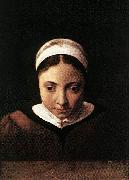 |
Cornelis van Poelenburch
|
|
(1594 - 12 August 1667) was a Dutch Golden Age landscape painter.
Though his birthplace is unknown, a signed document survives in Utrecht where he is listed as six years old and the son of Simon van Poelenburch, a Catholic canon in Utrecht.He initially trained with Abraham Bloemaert, and his earliest signed paintings are from 1620.He traveled to Rome where he was influenced by Adam Elsheimer and became a founding member of the Bentvueghels. He counted a few cardinals under his patrons, and was called to England by Charles I of England, for whom he made small cabinet pieces. He returned to Utrecht where he later died just a few years after his old teacher Abraham Bloemaert.He painted mostly small landcapes with mythical or religious figures or passages, in a style that would later be evident in some of the works of Claude Lorraine.
His "most important and successful" pupils were Daniël Vertangen, Dirck van der Lisse, François Verwilt, and Jan van Haensbergen. Arnold Houbraken claimed that his best pupil was Joan vander Lis from Breda (not Dirk vander Lis from The Hague). Houbraken then mentioned Vertangen, Verwilt, Warnard van Rysen from Bommel, and Willem van Steenree, a nephew. The RKD also mentions Laurens Barata. |
|
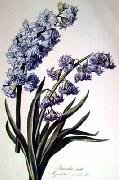 |
Cornelis van Spaendonck Prints
|
|
Dutch 1756-1840
Cornelis van Spaendonck (7 December 1756 - 22 December 1839) was a Dutch painter who was a native of Tilburg. Spaendonck initially worked under artist Guillaume-Jacques Herreyns (1743-1827) in Antwerp, and in 1773 moved to Paris to study and work with his brother, floral painter G??rard van Spaendonck (1746-1822). From 1785 to 1800, Cornelis van Spaendonck was head of the porcelain works at S??vres. Due to difficulties encountered as an administrator, he was relieved of his directorship in 1800, but remained at S??vres as a designer and artist until 1808.
In 1789 Spaendonck became a member of the Acad??mie des Beaux Arts. He painted throughout his lifetime, and displayed his works at the Salons of Paris until 1833. Most of Spaendonck's works were created with oils and gouache, and he is remembered for his lush still-lifes of flowers. Among his paintings were subjects such as De Fleurs Et Fruits, Vase De Fleurs, Bouquet De Different Fleurs, Fleurs Du Jardin, Corbeille Fleurs, et al. At his death in 1840 there were 29 paintings in his studio, which were auctioned soon afterwards. |
|
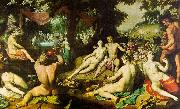 |
Cornelisz van Haarlem
|
|
1562-1638
Dutch
Cornelisz van Haarlem Galleries
Dutch painter and draughtsman. He came from a wealthy family. During the Spanish siege and occupation of Haarlem (1572-7), his parents moved elsewhere, leaving their son and large house in the protection of the painter Pieter Pietersz. (1540/41-1603), who became Cornelis's teacher. In 1579 Cornelis travelled to France by sea, but the journey terminated at Rouen because of an outbreak of plague. He then became a pupil of Gillis Congnet in Antwerp, with whom he stayed for one year. In 1580-81 he returned permanently to Haarlem, and in 1583 he received his first official commission from the city, a militia company portrait, the Banquet of the Haarlem Civic Guard (Haarlem, Frans Halsmus.). Around 1584 he befriended Hendrick Goltzius and Karel van Mander, with whom he is said to have established a kind of academy. |
|
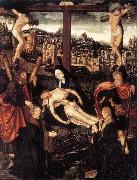 |
CORNELISZ VAN OOSTSANEN, Jacob
|
|
Dutch Northern Renaissance Painter, ca.1472-1533
North Netherlandish painter, designer and woodcutter. He was the brother of Cornelis Buys I ( fl 1490-1524), who is usually identified as the MASTER OF ALKMAAR (see MASTERS, ANONYMOUS, AND MONOGRAMMISTS, |
|
|
|
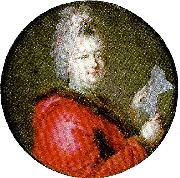 |
cornelius hoyer
|
|
Cornelius Höyer, född 1741, död 1804, var en dansk målare.
Höyer studerade dels i Köpenhamn, dels i Paris och Italien samt var redan 1769, då han återkom hem, en ansedd konstnär inom sitt fack, miniatyrmåleriet. 1770 blev han hovminiatyrmålare och medlem av konstakademien. Från 1777 var han dennas sekreterare.
|
|
|
|
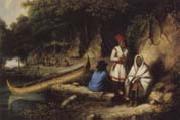 |
Cornelius Krieghoff
|
|
Dutch-born Canadian Painter, 1815-1872
Canadian painter of Dutch birth. He learnt the rudiments of music and painting from his father and about 1830 attended the Akademie der Bildenden Kenste in D?sseldorf. He moved to America c. 1835 and enlisted in the US army. In New York he met Louise Gauthier, a French-Canadian, and settled in Montreal with her in 1840, working as a painter and a musician. In 1842-3 he had a studio in Rochester, NY; in the following year he studied in Paris, making copies in the Louvre. Returning to Canada in 1845, he painted portraits in Toronto, and from 1845 to 1853 he lived in Longueuil and then in Montreal, where he produced genre paintings, landscapes and portraits. He exhibited in Montreal and Toronto, and a series of lithographs were published after his drawings. However, he found it difficult to sell his work in Montreal and had to resort more or less completely to sign-painting for a living. About 1853, at the instigation of the auctioneer John Budden, Krieghoff settled in Quebec City. He lived there for 11 years, making several trips to Europe. During this period of intensive production, he achieved popularity and prosperity and painted his best-known pictures, which were scenes depicting the local townspeople and the North American Indians, and views of Quebec City and the surrounding region. About 1858 he made panoramic paintings of Canada for the Provincial Parliament buildings in Quebec. From 1864 to 1867 he lived in Paris and Munich, |
|
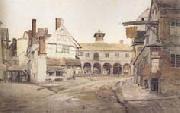 |
Cornelius Varley
|
|
English Painter, 1781-1873
Painter, draughtsman and printmaker, brother of (1) John Varley. Primarily a scientist, he painted watercolours for pleasure. He was less prolific than his brother. Although he was also a founder-member of the Society of Painters in Water-Colours, he exhibited few watercolours there from 1805 to 1820 and even fewer at the Royal Academy and the Society of British Artists between 1820 and 1859 and 1826 and 1844 |
|
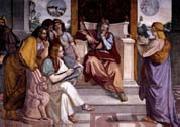 |
CORNELIUS, Peter
|
|
1824-1874,German composer. Trained as actor and violinist, and friend of artists, poets and writers, he devoted himself to music from the 1840s, finding inspiration in Liszt and the New German School at Weimar in 1852. His first mature works were the lieder opp. 1 and 2 and the song cycle Trauer und Trost op.3, followed by the comic opera Der Barbier von Bagdad (1855-8); all show his literary skill, refreshing simplicity and musical independence from the Liszt circle. In Vienna (1859-65), he wrote his second opera Der Cid and enjoyed fruitful relationships with Brahms, Carl Tausig and above all Wagner, who summoned him to Munich in 1865 as his private repetiteur and teacher at the Royal School of Music. His third opera Gunlöd was never finished. He continued to write poetry and essays defending Wagner and Liszt and translated vocal works by Pergolesi, Berlioz, Liszt and others. Although he revered Wagner, he stood ethically and artistically apart, his work (especially Der Barbier) thus representing an original achievement. |
|
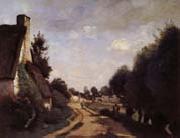 |
Corot Camille
|
|
French Realist Painter ,
1796-1875
French painter, draughtsman and printmaker. After a classical education at the Coll?ge de Rouen, where he did not distinguish himself, and an unsuccessful apprenticeship with two drapers, Corot was allowed to devote himself to painting at the age of 26. He was given some money that had been intended for his sister, who had died in 1821, and this, together with what we must assume was his family's continued generosity, freed him from financial worries and from having to sell his paintings to earn a living. Corot chose to follow a modified academic course of training. He did not enrol in the Ecole des Beaux-Arts but studied instead with Achille Etna Michallon and, after Michallon's death in 1822, with Jean-Victor Bertin. Both had been pupils of Pierre-Henri Valenciennes, and, although in later years Corot denied that he had learnt anything of value from his teachers |
|
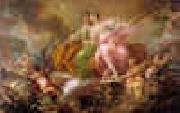 |
Corrado Giaquinto
|
|
1703-1766
Italian
Corrado Giaquinto Galleries
He was born in Molfetta. As a boy he apprenticed with a modest local painter Saverio Porta, (c1667-1725), escaping the religious career his parents had intended for him. By October 1724, he left Molfetta, and along with his contemporaries Francesco de Mura (1696-1784) and Giuseppe Bonito (1707-1789), he trained from 1719-23 in the prolific Neapolitan studio of Francesco Solimena, either with Solimena or his pupil, Nicola Maria Rossi. Throughout his life, Giaquinto was a peripatetic painter, with long sojourns in Naples, Rome (between 1723-53), Turin (1733 and 1735-9), and Madrid (1753-1761).
In 1723, he moved to Rome to work in the studio of Sebastiano Conca. He painted in San Lorenzo in Damaso, San Giovanni Calibita, and the ceiling at Santa Croce in Gerusalemme. In March 1727, with Giuseppe Rossi as an assistant, Giaquinto opened an independent studio near the Ponte Sisto, in the parish of Saint Giovanni of the Malva in Rome. In 1734, he married Caterina Silvestri Agate.
The first documented work by his hand is Christ crucified with the Madonna, Saint John Evangelist, and Magdalene commissioned in 1730 by king John V of Portugal for the cathedral of the Mafra. In 1731, he received a prestigious commission, to execute frescoes in the church of San Nicola dei Lorenesi: Saint Nicholas water gush from cliff, three theologic and cardinal Virtues, and in the cupola Paradise. The latest restoration confirms Giaquinto stylistic independence from Solimena, and reveals his stylistic dependence on Luca Giordano. |
|
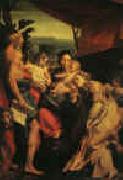 |
Correggio
|
|
Italian 1489-1534
Correggio Locations
Italian painter and draughtsman. Apart from his Venetian contemporaries, he was the most important northern Italian painter of the first half of the 16th century. His best-known works are the illusionistic frescoes in the domes of S Giovanni Evangelista and the cathedral in Parma, where he worked from 1520 to 1530. The combination of technical virtuosity and dramatic excitement in these works ensured their importance for later generations of artists. His altarpieces of the same period are equally original and ally intimacy of feeling with an ecstatic quality that seems to anticipate the Baroque. In his paintings of mythological subjects, especially those executed after his return to Correggio around 1530, he created images whose sensuality and abandon have been seen as foreshadowing the Rococo. Vasari wrote that Correggio was timid and virtuous, that family responsibilities made him miserly and that he died from a fever after walking in the sun. He left no letters and, apart from Vasari account, nothing is known of his character or personality beyond what can be deduced from his works. The story that he owned a manuscript of Bonaventura Berlinghieri Geographia, as well as his use of a latinized form of Allegri (Laetus), and his naming of his son after the humanist Pomponius Laetus, all suggest that he was an educated man by the standards of painters in this period. The intelligence of his paintings supports this claim. Relatively unknown in his lifetime, Correggio was to have an enormous posthumous reputation. He was revered by Federico Barocci and the Carracci, and throughout the 17th and 18th centuries his reputation rivalled that of Raphael. |
|
|
|
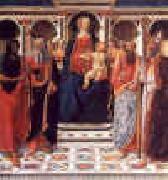 |
Cosimo Rosselli
|
|
Italian
1439-1507
Cosimo Rosselli Gallery
Born in Florence, at the age of fourteen he became a pupil of Neri di Bicci, and in 1460 he worked as assistant to his cousin Bernardo di Stefano Rosselli. A first youthful work of Cosimo mentioned by Giorgio Vasari is the Assumption of the Virgin altarpiece in the third chapel on the left of the nave in Sant'Ambrogio in Florence. In the same church, on the wall of one of the chapels, is a fresco by Cosimo which Vasari praises highly, especially for a portrait of the young scholar Pico of Mirandola. The scene, a procession bearing a miracle-working chalice, is painted with vigor and less mannerism than most of this artist's work. A picture painted by Rosselli for the church of the Annunziata, with figures of SS. Barbara, Matthew and the Baptist, is in the Academy of Florence.
Rosselli also spent some time in Lucca, where he painted several altar-pieces for various churches. A picture attributed to him, taken from the church of St. Girolamo at Fiesole, is now in the National Gallery of London. It is a large retable, with, in the center, St. Jerome in the wilderness kneeling before a crucifix, and at the sides standing figures of St. Damasus and St. Eusebius, St. Paula and St. Eustochium; below is a predella with small subjects. Though dry and hard in treatment, the figures are designed with much dignity.
The Berlin Gallery possesses three pictures by Rosselli: The Virgin in Glory, The Entombment of Christ, and The Massacre of the Innocents. In 1480 Rosselli, together with the chief painters of Florence, was invited by Pope Sixtus IV to Rome to assist in the painting of the frescoes in the Sistine Chapel. Three of these were executed by him The Destruction of Pharaohs Army in the Red Sea, Christ Preaching by the Lake of Tiberias, and The Last Supper. Rosselli's Sistine frescoes were partly painted by his assistant and son in law Piero di Cosimo, who was so called after Cosimo Rosselli. His chief pupil was Fra Bartolomeo.
According to Vasari, Rosselli died in 1484, but this is a mistake, as his is known to be living on 25 November 1506 |
|
 |
Cosimo Tura
|
|
1430-95
Italian Cosimo Tura Galleries
Cosimo Tura (c. 1430 ?C 1495), also known as Il Cosm?? or Cosme Tura, was an Italian early-Renaissance (or Quattrocento) painter and considered one of the founders of the School of Ferrara.
Born in Ferrara, he was a student of Francesco Squarcione of Padua. Later he obtained patronage from both Dukes Borso and Ercole I d'Este. By 1460, he was stipended by the Ferrarese Court. His pupils include Francesco del Cossa and Francesco Bianchi. He appears influenced by Mantegna's and Piero della Francesca's quattrocento styles.
In Ferrara, he is well represented by frescoes in the Palazzo Schifanoia (1469?C71) . This pleasure palace, with facade and architecture of little note, belonged to the d'Este family and is located just outside the medieval town walls. Cosimo, along with Francesco del Cossa, helped produce an intricately conceived allegorical series about the months of the year and zodiac symbols. The series contains contemporary portraits of musicians, laborers, and carnival floats in idyllic parades. As in Piero della Francesca's world, the unemotive figures mill in classical serenity.
He also painted the organ doors for the Duomo showing the Annunciation (1469). He collaborated in the painting of a series of "muses" for a studiolo of Leonello d'Este, including the allegorical figure of Calliope at the National Gallery (see image). While the individual attributions are often debated, among the artists thought to complete the Angelo di Pietro da Sienna, also called Maccagino or Angelo Parrasio, and Michele Pannonio. |
|
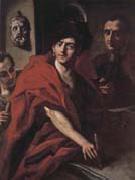 |
Cosmas Damian asam
|
|
1686-1739
Tegernsee, Bavaria died April 29, 1750, Mannheim, Palatinate) Bavarian architects and decorators. After studying in Rome (1711 C 13), Cosmas Damian became a prolific fresco painter, and his brother, Egid Quirin, became a sculptor and stuccoist. They developed the effects of dramatic lighting and illusionism originated by Gian Lorenzo Bernini and Andrea Pozzo. Working as a team, they produced magnificent illusionistic decoration in ecclesiastical buildings, combining dramatic lighting and colour. Their works are notable for their profound and dramatic intensity of religious feeling. The brothers became the principal late Baroque exponents of illusionist decoration in religious architecture. Their most notable collaboration is the church of St. John Nepomuk in Munich |
|
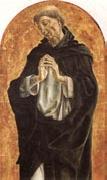 |
Cosme Tura
|
|
Italian Early Renaissance Painter, ca.1430-1495
Italian Renaissance artist. He was a leading master of the school of Ferrara and court painter to the city's ruling Este family. Often vividly emotional, Tura's figures range from the graceful to the grotesque, as in the gentle Mary and contorted Jesus of his c.1472 Pieta (Correr Museum, Venice). Combining material splendor with asceticism, his stylistically idiosyncratic paintings are frequently filled with sharply portrayed natural details??diversified landscapes, squirrels, monkeys, fruits, etc.??that serve as both plastic and iconographic elements. His works are executed in a harsh, nervously linear, and rather angular style, with bold and sometimes strident coloring. Examples of his art include two organ panels, Annunciation and St. George Slaying the Dragon (cathedral, Ferrara); Christ on the Cross (Milan); St. Jerome (National Gall., London); Portrait of a Man and Saints (National Gall. of Art, Washington, D.C.). Attributed to him is a portrait of a member of the Este family, The Flight into Egypt, and St. Louis of Toulouse |
|
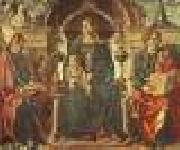 |
COSSA, Francesco del
|
|
Italian Early Renaissance Painter, ca.1435-1477
Italian painter. Together with Cosimo Tura and Ercole de' Roberti, Cossa was one of the most important painters working in Ferrara and Bologna in the second half of the 15th century. With them he shared an expressive use of line and solidity of form, but he also had a gift for decorative and anecdotal scenes, most evident in the frescoes in the Palazzo Schifanoia, Ferrara. |
|
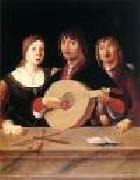 |
COSTA, Lorenzo
|
|
Italian High Renaissance Painter, ca.1460-1535
was an Italian painter of the Renaissance. He was born at Ferrara, but moved to Bologna by the his early twenties, and would be more influential to the Bolognese school of painting. However, many artists worked in both nearby cities, and thus others consider him a product of the School of Ferrara. There are claims that he trained with Cosimo Tura. In 1483 he painted his famous Madonna and Child with the Bentivoglio family, and other frescoes, on the walls of the Bentivoglio chapel in San Giacomo Maggiore, and he followed this with many other works. He was a great friend of Francesco Francia, who was much influenced by him. In 1509 he went to Mantua, where his patron was the Marquis Francesco Gonzaga, and he eventually died there. His Madonna and Child enthroned is in the National Gallery, London, but his chief works are at Bologna. His sons, Ippolito and Girolamo, were also painters, and so was Girolamo's son, Lorenzo the younger (1537-1583). |
|
|
|
|
|
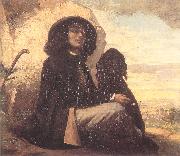 |
Courbet, Gustave
|
|
French Realist Painter, 1819-1877
Gustave Courbet was born at Ornans on June 10, 1819. He appears to have inherited his vigorous temperament from his father, a landowner and prominent personality in the Franche-Comt region. At the age of 18 Gustave went to the College Royal at Besançon. There he openly expressed his dissatisfaction with the traditional classical subjects he was obliged to study, going so far as to lead a revolt among the students. In 1838 he was enrolled as an externe and could simultaneously attend the classes of Charles Flajoulot, director of the cole des Beaux-Arts. At the college in Besançon, Courbet became fast friends with Max Buchon, whose Essais Poetiques (1839) he illustrated with four lithographs. In 1840 Courbet went to Paris to study law, but he decided to become a painter and spent much time copying in the Louvre. In 1844 his Self-Portrait with Black Dog was exhibited at the Salon. The following year he submitted five pictures; only one, Le Guitarrero, was accepted. After a complete rejection in 1847, the Liberal Jury of 1848 accepted all 10 of his entries, and the critic Champfleury, who was to become Courbet's first staunch apologist, highly praised the Walpurgis Night. Courbet achieved artistic maturity with After Dinner at Ornans, which was shown at the Salon of 1849. By 1850 the last traces of sentimentality disappeared from his work as he strove to achieve an honest imagery of the lives of simple people, but the monumentality of the concept in conjunction with the rustic subject matter proved to be widely unacceptable. At this time the notion of Courbet's "vulgarity" became current as the press began to lampoon his pictures and criticize his penchant for the ugly. His nine entries in the Salon of 1850 included the Portrait of Berlioz, the Man with the Pipe, the Return from the Fair, the Stone Breakers, and, largest of all, the Burial at Ornans, which contains over 40 life-size figures whose rugged features and static poses are reinforced by the somber landscape. A decade later Courbet wrote: "The basis of realism is the negation of the ideal. Burial at Ornans was in reality the burial of romanticism." In 1851 the Second Empire was officially proclaimed, and during the next 20 years Courbet remained an uncompromising opponent of Emperor Napoleon III. At the Salon of 1853, where the painter exhibited three works, the Emperor pronounced one of them, The Bathers, obscene; nevertheless, it was purchased by a Montpellier innkeeper, Alfred Bruyas, who became the artist's patron and host. While visiting Bruyas in 1854 Courbet painted his first seascapes. Among them is the Seashore at Palavas, in which the artist is seen waving his hat at the great expanse of water. In a letter to Jules Vall's written in this period Courbet remarked: "Oh sea! Your voice is tremendous, but it will never succeed in drowning out the voice of Fame shouting my name to the entire world." Courbet was handsome and flamboyant, naively boastful, and aware of his own worth. His extraordinary selfconfidence is also evident in another painting of 1854, The Meeting, in which Courbet, stick in hand, approaches Bruyas and his servant, who welcome him with reverential attitudes. It has recently been shown that the picture bears a relationship to the theme of the Wandering Jew as it was commonly represented in the naive imagery of the popular Épinal prints. Of the 14 paintings Courbet submitted to the Paris World Exhibition of 1855, 3 major ones were rejected. In retaliation, he showed 40 of his pictures at a private pavilion he erected opposite the official one. In the preface to his catalog Courbet expressed his intention "to be able to represent the customs, the ideas, the appearance of my own era according to my own valuation; to be not only a painter but a man as well; in short, to create living art." One of the rejected works was the enormous painting The Studio, the full title of which was Real Allegory, Representing a Phase of Seven Years of My Life as a Painter. The work is charged with a symbolism which, in spite of obvious elements, remains obscure. At the center, between the two worlds expressed by the inhabitants of the left and right sides of the picture, is Courbet painting a landscape while a nude looks over his shoulder and a child admires his work. Champfleury found the notion of a "real allegory" ridiculous and concluded that Courbet had lost the conviction and simplicity of the earlier works. Young Ladies by the Seine (1856) only served to further convince the critic of Courbet's diminished powers. But if Courbet had begun to disappoint the members of the old realist circle, his popular reputation, particularly outside France, was growing. He visited Frankfurt in 1858-1859, where he took part in elaborate hunting parties and painted a number of scenes based on direct observation. His Stag Drinking was exhibited in Besançon, where Courbet won a medal, and in 1861 his work, as well as a lecture on his artistic principles, met with great success in Antwerp. With the support of the critic Jules Castagnary, Courbet opened a school where students dissatisfied with the training at the cole des Beaux-Arts could hear him extol the virtues of independence from authority and dedication to nature. |
|
 |
COURTOIS, Jacques
|
|
French Baroque Era Painter, 1621-1676
was a French painter. He was born at Saint-Hippolyte, near Besançon. His father was a painter, and with him Jacques remained studying up to the age of fifteen. Towards 1637 he went to Italy, was received at Milan by a Burgundian gentleman, and entered, and for three years remained in the French military service. The sight of some battle-pictures revived his taste for fine art. He went to Bologna, and studied under the friendly tutelage of Guido Reni; thence he proceeded to Rome, where he painted, in the Cistercian monastery, the "Miracle of the Loaves." Here he took a house and after a while entered upon his own characteristic style of art, that of battle-painting, in which he has been accounted to excel all other old masters; his merits were cordially recognized by the celebrated Cerquozzi, named Michelangelo delle Battaglie. He soon rose from penury to ease, and married a painter's daughter, Maria Vagini; she died after seven years of wedded life. Prince Matthias of Tuscany employed Courtois on some striking works in his villa, Lappeggio, representing with much historical accuracy the princes military exploits. In Venice also the artist executed for the senator Sagredo some remarkable battle-pieces. In Florence he entered the Society of Jesus, taking the habit in Rome in 1655; it was calumniously rumoured that he adopted this course in order to escape punishment for having poisoned his wife. As a Jesuit Brother, Courtois painted many works in churches and monasteries of the society. He lived piously in Rome, and died there of apoplexy on 20 May 1676 (some accounts say 1670 or 1671). His battle-pieces have movement and fire, warm colouring (now too often blackened), and great command of the brush, those of moderate dimensions are the more esteemed. They are slight in execution, and tell out best from a distance. |
|
|
|
|
|
|

